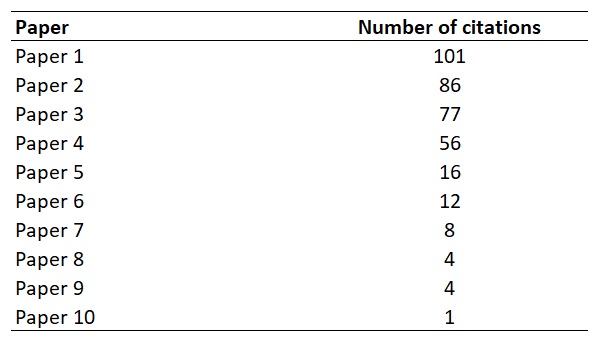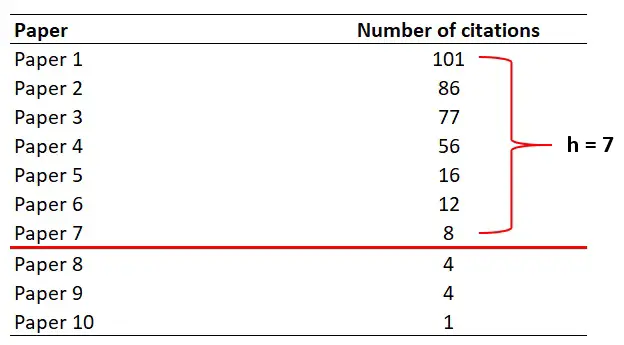What is the h-index?
You may have heard academics talk about their h-index, but, what exactly is the h-index? The h-index is an author-level metric that determines your research output which takes into account the number of publications you have with the highest number of citations. It is essentially a figure used to denote how much impact, therefore research quality, your work has.
The h-index was proposed in 2005 by Jorge E. Hirsch in his publication to the PNAS journal. In it, Hirsch explained what the h-index denotes and how to calculate it. Here is a quote which has been taken from his 2005 paper:
‘A scientist has index h if h of his or her papers (Np) have at least h citations each and the other (Np – h) papers have ≤h citations each’.
How to calculate the h-index
Let’s say we have an h-index of 7. What does this mean? This means that our top 7 most-cited publications have at least 7 citations each. Thus, an h-index of 10 would mean that 10 of our publications have 10 or more citations each, etc.
To understand the h-index better, I find it useful to present an example. Let’s say a researcher has 10 publications. I have listed the 10 publications below, sorted descendingly by the number of citations each has received.
 By using the definition used by Hirsch above, we can see that the h-index in this example would be 7. Why? Because this researcher has 7 papers that have 7 or more citations each.
By using the definition used by Hirsch above, we can see that the h-index in this example would be 7. Why? Because this researcher has 7 papers that have 7 or more citations each.
 To improve the h-index of this researcher from 7 to 8, this would mean that Paper 8, 9 or 10 will have to generate 8 or more citations.
To improve the h-index of this researcher from 7 to 8, this would mean that Paper 8, 9 or 10 will have to generate 8 or more citations.
How to find your h-index automatically
Finding your h-index is pretty easy, however, it may vary depending upon the database you use to retrieve this data. Here is a list of free resources to use which calculate your h-index automatically for you and a brief guide on how to find the information:
Google Scholar
The Google Scholar database includes over 160 million documents including most peer-reviewed papers, conference papers and theses. This is my personal source of choice for determining my h-index since the database captures most of my academic work.
To find your h-index by using Google Scholar:
- Create a Google Scholar account for free by using a Google email account.
- Follow the instructions to set up your profile.
- Google Scholar will retrieve some documents for you to attach to your account. For the most accurate h-index calculations, ensure you attach as many pieces of work to your profile as possible.
- Go to your profile page and you should see the citation data, including the h-index, in the top-right corner.
- Google Scholar also calculates the i10-index metric, which indicates how many papers you have which have at least 10 citations.
Scopus
Scopus is database owned by Elsevier covering over 22,000 peer-reviewed journals.
To find your h-index by using Scopus:
- Use the ‘Author search‘ page to find yourself in the Scopus database. You can also include an affiliation to further filter the results.
- Find yourself on the list and click on your name.
- You will then be taken to a profile page of that author containing detailed information including the h-index, citations and list of manuscripts.
ResearchGate
ResearchGate is somewhat different in that it is a social networking platform for research scientists. Of interest, here are some reasons why you should be using ResearchGate. Within the ResearchGate platform there also contains a vast database of published work that can be used to populate your h-index.
To find your h-index by using ResearchGate:
- Create a ResearchGate account for free.
- Follow the instructions to set up your account.
- Add as many manuscripts as possible to your account either manually or as populated by ResearchGate.
- Once set up, go to your profile page. Here, select the ‘Scores‘ button. Your h-index should be displayed on this page.
Publish or Perish
Publish or Perish is a free downloadable program created by Anne-Wil Harzing which uses the Google Scholar database. It is fast and an efficient way of finding metric information, without the need to sign-up for a Google Scholar account. As well as reporting the h-index, other data is also displayed such as g-index and citations per year.
To find your h-index by using Publish or Perish:
- Download and install the Publish or Perish program from the Harzing website.
- Open up the program and select the ‘New > Google Scholar Query‘ button under the ‘Query‘ section.
- Enter your name into the ‘Authors‘ bar and click the ‘Lookup‘ button.
- The metric information will then be displayed on the bottom left side of the program.
Web of Science
The Web of Science platform has coverage of over 33,000 journals. While still capable of calculating your h-index, I personally found Web of Science to be the worst performer of the options available.
To find your h-index by using Web of Science:
- Use the search bar to search for your name. Under the search options, select ‘Author‘.
- When you find your name, sometimes you have to click on an article first then your name, Web of Science will display the manuscripts attached to you.
- In the top-right corner of these search results, click the ‘Create citation report‘ option.
- This will return a detailed report containing your h-index.




Very useful tutorial,
Regards
thank you for your input, Steven, it was a good balanced view of how to retrieve the h index.
best
wolfgang